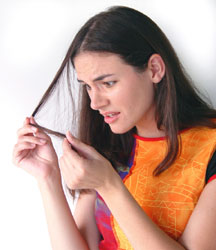Damaged Hair
What damages your hair?
Different ways your hair gets damaged
As mentioned before, the cuticle is the part of your hair that gets damaged.
The different ways your hair gets damaged that I'll cover are: Friction, Tension, and Chemical Processing.
FRICTION: When there is friction against your hair, the cuticle erodes and causes swelling that leads to even more friction. If the cuticle erodes to a severe degree, it can damage the cortex as well. Against common belief, brushing your hair when it is wet actually damages it more because the hair is in a fragile state.
TENSION: This is an extremely sad truth for most girls. Styling, braiding, and updo-ing your hair is generally bad for it. Though it is not terribly bad, it does cause tension that leads to broken hair, and weak cuticles.
CHEMICAL PROCESSING: Chemically processing your hair leads to internal chemical changes to your hair that leads to friction. Processed hair is also more hydrophilic. This means that our hair wants water. More mechanical damage can occur when our cuticles lift from a surplus of water. Furthermore, oils and conditioners become less attracted to our hair after chemical processing. This is extremely dangerous because after dyeing, perming, etc., is when we need oils and conditioners the most!
The different ways your hair gets damaged that I'll cover are: Friction, Tension, and Chemical Processing.
FRICTION: When there is friction against your hair, the cuticle erodes and causes swelling that leads to even more friction. If the cuticle erodes to a severe degree, it can damage the cortex as well. Against common belief, brushing your hair when it is wet actually damages it more because the hair is in a fragile state.
TENSION: This is an extremely sad truth for most girls. Styling, braiding, and updo-ing your hair is generally bad for it. Though it is not terribly bad, it does cause tension that leads to broken hair, and weak cuticles.
CHEMICAL PROCESSING: Chemically processing your hair leads to internal chemical changes to your hair that leads to friction. Processed hair is also more hydrophilic. This means that our hair wants water. More mechanical damage can occur when our cuticles lift from a surplus of water. Furthermore, oils and conditioners become less attracted to our hair after chemical processing. This is extremely dangerous because after dyeing, perming, etc., is when we need oils and conditioners the most!
Tips from http://thebeautybrains.com/2006/11/28/top-10-split-end-busters/
1) Move Your Mane
If your hair is long enough to get caught under coat collars or under shoulder straps (for Messenger bags, back pack, etc) then be sure to move your hair before putting on that bag.
2) Keep Air off Your Hair
Does your hair whip in the wind? Wind knots up hair. Knots damage length. Damaged length causes more splits. Eventually the damaged length splits. Restrain your hair when you are going to be in a lot of wind.
3) Wash Warily
Only apply shampoo to roots where it needs it. Avoid washing the dried out ends.
4) Be Picky About Piling Hair On Top
Do you pile your hair on top of your head when you shampoo? This creates MANY opportunities for splits. Shampoo really only needs to be applied to your roots. That’s where the grease/oil is. Personally, I condition the length of my hair, apply shampoo to my scalp (down to ears), rinse, then apply conditioner again, rinse. This is called CWC (Condition Wash Condition). All the while, the length of my hair just hangs down my back.
5) Towel Drying is Treacherous
When you dry your hair, do you scrub your scalp with a towel? It feels great, but it will rip, strip, pop, snap and fry your hair in no time! Many of us use some sort of a turbie type towel/turban for drying our hair. Others put a towel on their back and let the hair drip onto the towel.
6) Blow Off Blow Drying
Do you blow dry your hair? The heat and the wind created by the blowfryer (no that isn’t a typo) really damages hair, too. Any heat styling tool can potentially damage hair. If you feel you must use them, keep the temperature low and exposure time to your hair short.
7) Subdue Your Shampoo
How often do you shampoo? Regardless of HOW you shampoo, how OFTEN do you do it? Many of us have found that 2-3 shampooings per week is sufficient. It takes a few weeks to train your scalp to have fewer washings, but it helps protect the ends. Not everyone has success with fewer shampooings, though.
Condition, condition, condition
Do you use conditioner or a cream rinse when you shampoo? My personal belief is, if you want long hair you need to condition it EVERY time you shampoo. If nothing else, it helps detangle my hair. You also might consider using a leave in conditioner, especially one that helps detangle (and gives slip).
9) Oil Often
You can oil the length of your hair daily. Many long hairs do this. They put a small drop in the palm of their hand, rub their hands together and lightly apply the oil to the ends only of the hair. There is an abundance of oils that you can use, some are quite exotic. Extra virgin olive oil (EVOO) is probably the most common, but there is a long list of oils everyone has tried and ones that each person likes/doesn`t like.
10) Consider Combing Cautiously
After you’ve shampooed, when/how do you brush/comb your hair? Generally, brushing wet hair is bad for the hair. Hair is most delicate when wet. Brushing tends to stretch the strands. Stretching the strands puts wear and tear, which causes damage, which causes splits.

